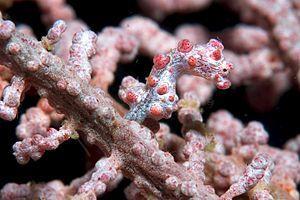
Pygmy Seahorse on gorgonian fan: difficult to spot if you are a predator (Photo credit: Wikipedia)
Imagine if you could create your own fantastical sea creature. Would you give it the ability to change color enabling it to hide from its predators; the ability to look forwards and backwards at the same time; a prehensile tail to cling on to vegetation; a body covered in armoured plates; a long horse-like snout and the ability to grow and reabsorb spines? And would you make it so it was the male that gave birth to its young? Sounds too weird? Well, if you made a creature looking like that, then you would in fact have created a real-life animal – a seahorse.
Seahorses are an amazing fish. Not only have they evolved all of the above clever adaptations, but they are also strangely beautiful to look at with their stately and graceful swimming style. I have maybe been a bit cheeky with the title of this post as, thanks to the warm waters of the Gulf Stream, we can find them living, breeding and swimming around much more of the UK coastline. But they are here in Cornwall and I’ve been enjoying finding out more about them. (I should say at the start that I owe a big thanks to Neil Garrick-Maidment, Director of The Seahorse Trust, and the Trust’s very informative web site, for information about seahorses in Cornwall, and permission to use photographs.)
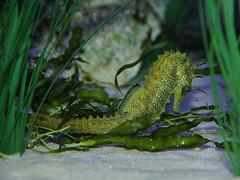
Spiny Seahorse (Hippocampus guttulatus) (Photo credit: Jeff Whitlock)
There are two species of seahorse in UK waters: the Short-snouted Seahorse (Hippocampus hippocampus, which secured a place on My Cornish Ark) and the Spiny Seahorse (Hippocampus guttulatus, with a longer snout and spines on its head and the top of its back). Both need seabed vegetation in which they can hide andhunt, and this dictates to a large extent where they are found in Cornish waters. The more choosy Spiny Seahorses (very much restricted to seagrass habitats) are mainly found along our south coast where there are large seagrass meadows, with Penzance Bay hosting a reasonably-sized population (NB. a group of seahorses is called a ‘herd’!). Short-snouted Seahorses can live in a wider variety of vegetation and are therefore more generally distributed. Both species also live around the Isles of Scilly. Even divers would be very lucky to see them, though – they are secretive and cryptic, most often seen when brought up accidentally by crab and lobster fishing.
Despite the few differences between them, our two native seahorses have a similar life history. Here are a few things I found out, but do get onto The Seahorse Trust website here for more in-depth information. I’ve also posted extra information, links and background on the What’s Wild in Cornwall Facebook page.
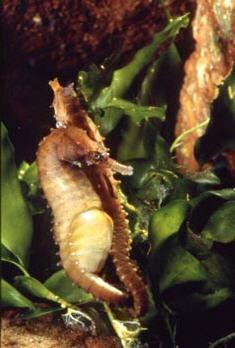
Pregnant male seahorse (photo credit: The Seahorse Trust)
- Each seahorse starts its life as a tiny ‘fry’ – a perfect miniature seahorse. It is actually the male that becomes pregnant – the eggs are transferred to him by the female and then fertilised by him and carried in his pouch. He gives birth to many hundreds of fry (the number varies between species) – check out this article and video for more (note the seahorse in the film is not a UK-native species). Very few of the fry – which eat plankton and are self-sufficient from birth – will survive – they make a tasty meal for other creatures.
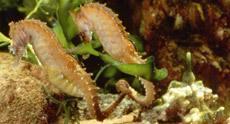
Courting seahorses (photo credit: The Seahorse Trust)
- Those seahorses that make it to maturity will generally pair for life. Their courtship dances are beautiful, and they meet every morning (the male and female in each pair hold separate but overlapping territories) to dance together – the secret of a good ‘marriage’, maybe?
- Unlike other fish, seahorses don’t have scales, but an exoskeleton of hard bony plates.
- They can see extremely well, and their eyes can in fact swivel independently of each other: they can see backwards and forwards at the same time – very useful when hunting for their prey of small crustaceans, especially as their upright posture, while graceful, means they are not fast swimmers.
As well as being fascinating in their own right, their sensitivity to environmental conditions makes them a good barometer of climate and ecosystem changes. Most of you will be aware of the impact of the Chinese medicine trade on seahorses, and they are also taken for the pet and curio trade. Closer to home, they are vulnerable to the impact of dredging, damaging fishing practices and anchorages which destroy their habitat (I’ve posted a great little animated film on the Facebook page about how this can avoided – check it out). Marine Conservation Zones will offer some protection, so why not get onto the DEFRA webpage to respond to the consultation and lobby for more Zones to go forward (it may not be in Cornwall, but Studland Bay in Dorset is an important site for seahorses).
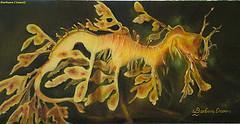
A seadragon – not a native, but too beautiful not to include! (Photo credit: Opals-On-Black.com)
In my next post I’ll give some information about other things we can do to help protect our marine environment in Cornwall. Seahorses are just one of the many important and interesting creatures we find beneath the waves, and they are worth fighting for.

